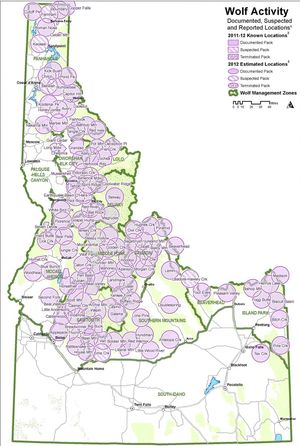Hunting, trapping slow to balance Idaho wolf numbers
PREDATORS -- Idaho's 2012 wolf monitoring report released Tuesday indicates the state is struggling to get 14 years of burgeoning wolf populations into some sort of sustainable balance with prey and social acceptance.
The Idaho Department of Fish and Game reports 683 wolves at the end of 2012, down from 746 wolves in 2011 -- an 11 percent decrease.
But the total number of packs has increased from 104 in 2011 to 117 in 2012. Wolves are moving in and out of the state, and a new crop of wolves is being born in dens across the state this month.
State wildlife officials attribute both the overall population downsizing and the increase in packs to continued pressure through hunting, trapping and agency control methods.
"Despite concerns expressed by some people that hunting and trapping would eliminate wolf packs, we haven’t found that to be the case,” said Jon Rachael, Fish and Game’s state big-game manager in Boise.
While the number of wolf packs increased, the average size of the packs decreased, Rachael said.
“That is exactly what we would expect to see with wolves being harvested by hunters and trappers,” he said. “Average pack size peaked in 2008 prior to our first hunting season, when we estimated an average of slightly more than eight wolves per pack, and has declined since then to about five wolves per pack now.”
Last year, the Idaho Fish and Game Commission increased bag limits, extended hunting seasons in some areas, allowed hunters to use electronic calls and certified more wolf trappers.
Idaho reports 418 wolves were killed by these means and the efforts of Wildlife Services to protect livestock
Yet the overall effort has barely made a dent in a wolf population that federal and state experts agree is too large for its own good.
For now, it’s the official policy of the Idaho Fish and Game Commission to continue reducing the number of wolves. Wildlife officials don't state a goal for Idaho's wolf population, noting only that the state legislature in 2002 committed to maintaining at least 150 wolves.
"Simply removing them one time doesn't mean they are gone," Rachael said. "They will backfill suitable habitat fairly quickly. That is why you can have a pretty high harvest rate with wolves and you don't see the population plummeting as some folks were predicting early on."

